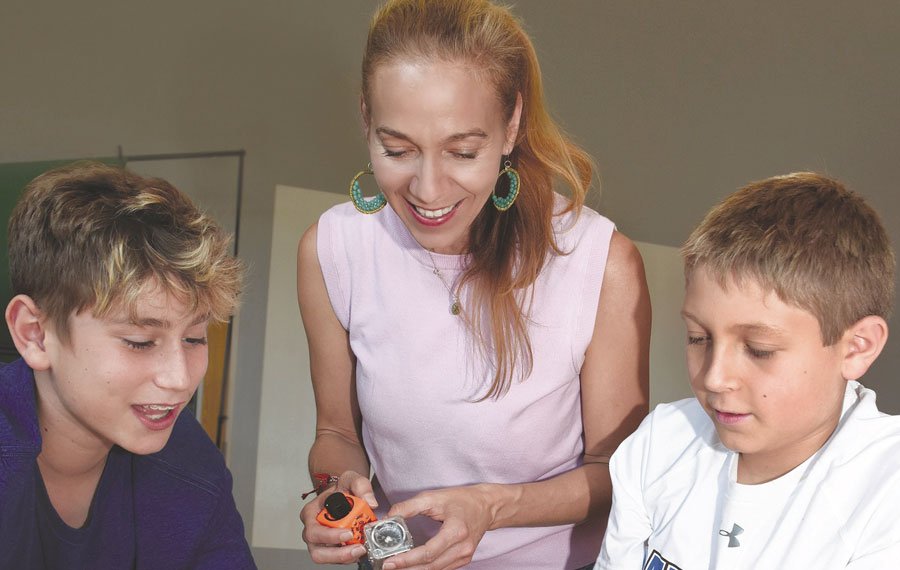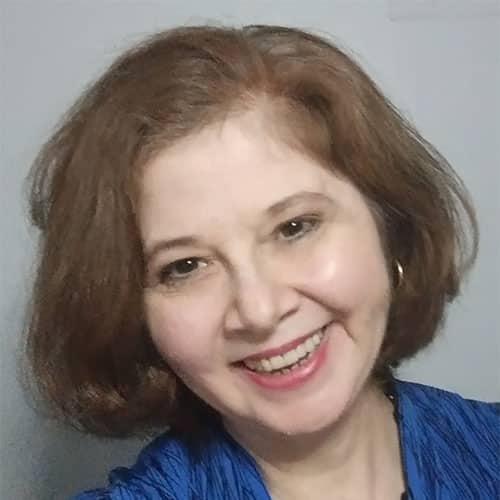 A teacher and students
in an X-Learning class at
Milken Middle School.
Photo by Andrea Smith
A teacher and students
in an X-Learning class at
Milken Middle School.
Photo by Andrea Smith How should students in the 21st century be educated? It’s a question that Milken Community Schools educators are taking seriously, particularly in their Middle School curricula.
“Traditional education worked for hundreds of years. It doesn’t anymore,” Milken’s middle school Principal Limor Dankner told the Journal. “We’re preparing students for jobs that haven’t been imagined yet. Studies have shown that everything we’re doing now will be obsolete by the time these [middle-school] children [graduate] from university,” she said. “So the only thing we can give them are those life tools that they can then adapt to whatever situation they’re in.”
For Dankner, that meant creating the school’s X-Learning program. Now in its sixth year, X-Learning is a blend of traditional and progressive teaching practices that allows students to connect what they learn to their interests, address real-world problems, engage in action and cultivate their problem-solving skills.
“We are anchored in those core tenets,” Dankner said, “but we keep tweaking [the approach], based on feedback [and] the shifts in the needs of students.”
At the heart of the X-Learning philosophy is that creativity is learned, immersive learning is key, curiosity must be reignited, innovation requires risk-taking and rigor, and design is at the center of it all.
When kids are very young, they often don’t hesitate to ask questions, Dankner said. However, she added: “As they get older, schools teach children to stop asking questions and to start answering them. They are so accustomed to giving the right answer, they are stumped when you ask them a question and say, ‘There isn’t an answer. You have to be a divergent thinker, you have to think out of the box, you have to work with other people, you have to keep iterating, you have to persevere if you’re ever going to come up with an answer to this question.’ ”
An example of Milken’s X-Learning approach can be seen in how it goes beyond traditional geometry classes. Geometry students are put into teams to build and test bridges, because that’s one of the real-world application of geometry. “They are immersed, creative, engaged,” Dankner said. “They’re owning their learning.”
There are four components of the X-Learning process:
Identification: Allowing students to pursue curiosities they have about their world.
Exploration: Interviews, research, collaboration, team-building, articulation, writing and speaking.
Purposeful Play: For students to be successful, they have to experiment in a space that is low-stakes/no grades
Connection: Learning to connect with content, areas of study, peers and adults.
“Ultimately, middle-schoolers are defined by the connections that they make or fail to make,” Dankner said. “Those are so important to shaping their identity. We want them to find like-minded people their age and older in the community. We want them to find areas of study or things in the world that are meaningful to them, because that’s what’s going to motivate them to do something.”
Every year, Milken participates in The X Project. The first semester is skill-building and the second semester is spent in exploration and research. Every middle-schooler identifies something they want to know more about or a problem that they want to solve. In March, they turn the entire campus into a conference center to showcase their work. Students have started businesses, developed apps and created gadgets, Dankner said.
“Not only are we fulfilling the curricula, but we’re
going over and above the requirements.”
— Limor Dankner
However, although innovation is key, Milken still teaches the basics.
“It’s not that we’re not teaching geometry, algebra or U.S. history,” Dankner said. “Not only are we fulfilling the curricula, but we’re going over and above the requirements. It’s the way in which we are reaching [and engaging] students that makes the material relevant, that gives them choice, that puts them in the driver’s seat and equips them with those skills that they will need to then utilize in future years.”
The students’ high standardized test scores and assessments indicate the school’s methods are working. “We keep raising the bar [in terms of academic rigor], and they keep rising to the occasion,” Dankner said. “And the test results are blowing us away. The more these kids are engaged in what feels like [and is] playful learning, the better they are doing academically.”
X-Learning also applies to Milken’s Jewish Studies department, too.
“Our whole spiritual practice and our holiday programming is designed with X-Learning in mind. So, it’s student-driven. It’s student-generated and there’s ample choice,” Dankner said. “We don’t herd all 200 students for a Friday morning Kabbalat Shabbat or prayer. We have multiple minyanim and multiple choices for students, which they have self-identified as relevant and inspirational.”
Milken also has developed an entire course on Israel, called Innovation Nation.
“The course tracks the history of Israel, but looks at it from the perspective of Israelis as innovators,” Dankner said. “The students are not only learning about Israel’s history, culture and philosophy, but they’re understanding it in a very relevant way. They are looking at California innovations and where those innovations are aligned with Israeli innovations.”
Dankner said she gets requests from other schools in Los Angeles to share Milken’s X-Learning information. “They want to send their teams here, they want to learn more about it,” she said. “We’re definitely making a name for ourselves. People are recognizing the value in this.”
However, if other schools look at this type of teaching as an adjunct or extracurricular process, it’s never going to work, Dankner said: “We don’t teach anything here in addition to, we just teach students, and this is how we teach them,” she said.
“You won’t find the Jewish Studies teachers doing their own shtick while the humanities teachers are doing theirs,” Dankner said. “Everyone is talking about how to integrate, how to present situations where students see the world as interrelated and not as separate compartments. It’s been an incredible ride.”
This story appeared in the 2018 Education Guide of the paper.























 More news and opinions than at a Shabbat dinner, right in your inbox.
More news and opinions than at a Shabbat dinner, right in your inbox.